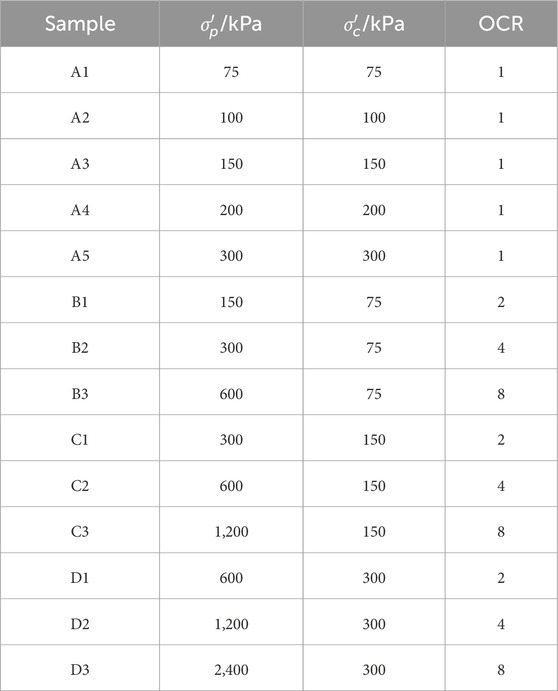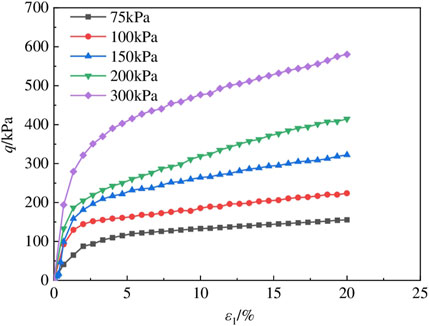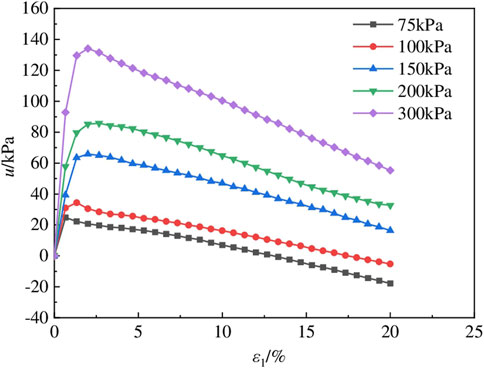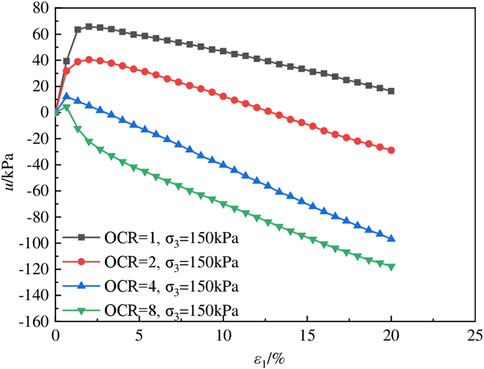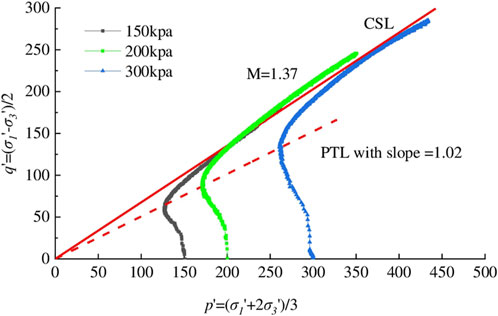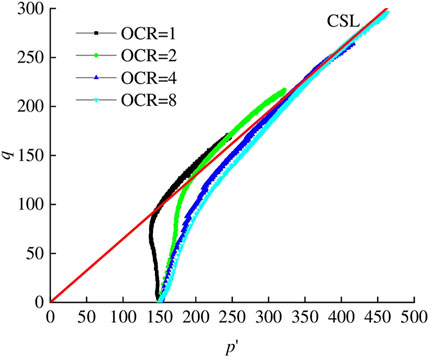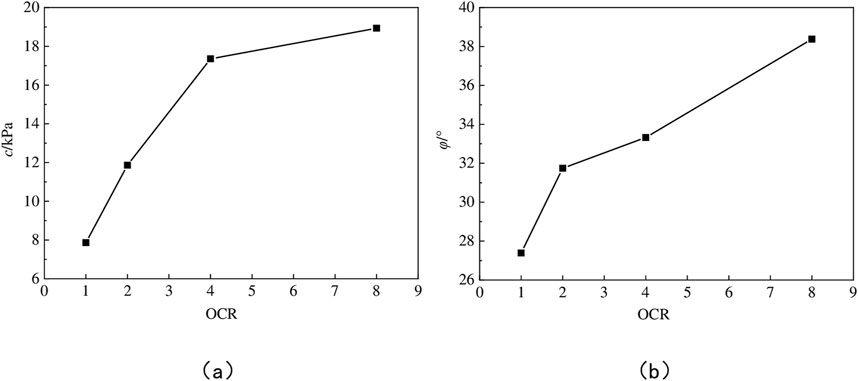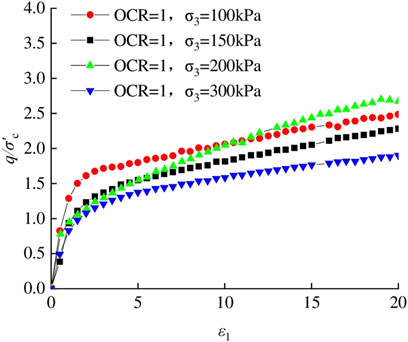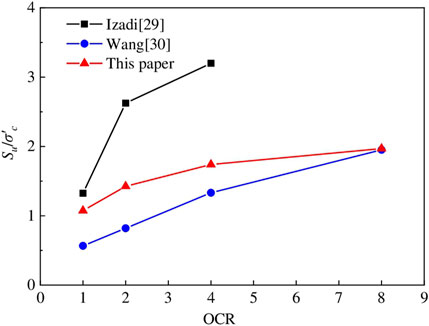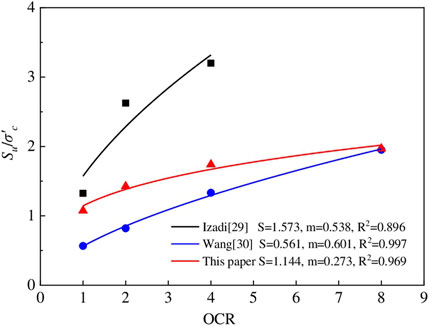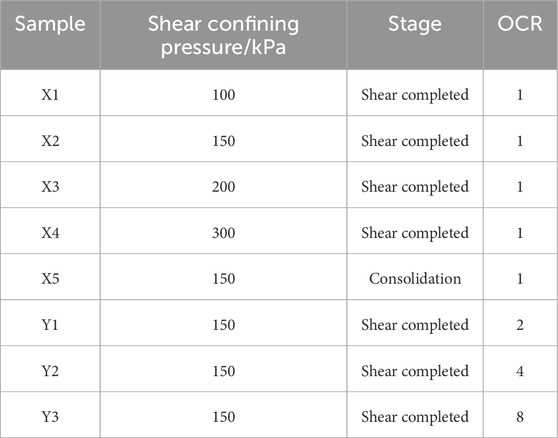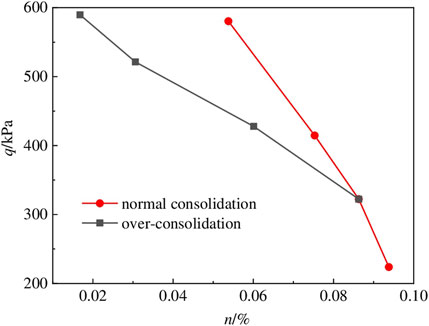- 1School of Civil Engineering, Zhengzhou University, Zhengzhou, China
- 2The Seventh Engineering Co., Ltd. of CCCC First Highway Engineering Co., Ltd., Zhengzhou, China
The foundation soil is often over-consolidated due to the change of soil consolidation history in practical engineering. The effect of over-consolidation ratio (OCR) on the mechanical properties and microstructure of silt has not been sufficiently studied especially on the Yellow River alluvial silt. A series of triaxial undrained shear tests and corresponding SEM tests of the Yellow River alluvial silt were then carried out under different confining pressures and OCRs. The stress and strain curves of the silt show strain-hardening characteristics. The hardening characteristics become more significant, and the peak stress increases significantly as the confining pressure and OCR increase. The silt specimens show phase transformation behavior under a normal consolidation state, which is characterized by stages of initial contraction, temporary phase transformation, and later dilation. The silt tends to be more dilative for over-consolidated specimens and the dilation behavior was more obvious with higher OCRs. The deviatoric stress of the silt can be normalized by the consolidation pressure. The normalized undrained shear strength of the silt generally increased with OCR. The cohesion and internal friction angle of the silt increase with OCR increasing which behaved more like the typical clays as it has more silt content and clay content. The apparent porosity decreases and the average shape coefficient increases with the increase of confining pressure and OCR which shows the silt is denser and the grain shape is closer to circular under higher confining pressure and OCR. The relationship between macroscopic strength characteristics and the microscopic apparent porosity is also discussed. It shows that the macroscopic peak strength gradually decreases with the increase of the microscopic apparent porosity. Such behavior is mainly caused by the internal pore volume reduction and the rise in the contact area between soil particles.
1 Introduction
In engineering practice, the foundation soil is often in an over-consolidated state due to the change in soil consolidation history. For example, the soil beneath the foundation where preloading is used to control settlement, the bottom soil during foundation excavation, and the soil experienced unloading caused by tunnel and underground pipe gallery excavation. Besides, the shallow layer of the foundation is normally overconsolidated, either naturally existing or caused by groundwater level fluctuation or the surcharge preloading in engineering practice. The Yellow River alluvial silt is widely distributed in the middle and lower reaches of the Yellow River Basin in China. It covers six provinces and accounting for 80% of the total silt in China (Xiao et al., 2014). The silt formed in the Yellow River Basin due to the breaches, changes of course, flooding and siltation of the river (or flood) in modern times belongs to water-formed silt. The silt has a high content of silt particles, a high degree of rounding, and a relatively large permeability. It has special engineering characteristics such as reduced moisture absorption strength and instability when encountering water (Song et al., 2010). The Yellow River alluvial silt often serves as the foundation for numerous infrastructure projects, posing significant risks to engineering projects due to these engineering characteristics. On the other hand, the soil mechanical properties under over-consolidation are quite different from those in normal consolidation state (Vithana et al., 2012; Li et al., 2017). The rebound potential of over-consolidated silt may lead to instability in excavation support systems and uneven settlement of structures. Additionally, its low permeability can result in a rapid rise in pore water pressure and a subsequent reduction in shear strength. Therefore, it is of great significance to study the influence of the over-consolidation ratio (OCR) on the mechanical properties of the Yellow River alluvial silt for the development of foundation engineering.
Many studies on the mechanical properties of over-consolidated soils have been carried out. Laboratory tests (Ladd, 1977) found that the change of shear confining pressure and consolidation confining pressure has a significant effect on the shear strength of the soil when the over-consolidation ratio is constant. Kulhawy and Mayne (1990) found that the undrained shear strength of saturated clay was positively correlated with OCR. Yang et al. (2019) concluded that the collapsibility of over-consolidated loess is obviously less than that of normal consolidated soil. Through triaxial tests, Hu et al. (2018) proposed an elastoplastic constitutive model, which can reflect the characteristics of deformation, dilatancy, and pore water pressure of cohesive soil under different OCRs. In addition, it is found that over-consolidated soil often shows significant shear strength and obvious dilatancy, and the characteristics of over-consolidated soil are often more complex (Fakharian et al., 2022; Wang et al., 2016; Lashkari et al., 2022; Wang et al., 2023; Nagase et al., 2000; Nazir, 2011).
The silt behaves quite differently from typical clays and sands due to its high fraction of silt and was not sufficiently studied. Silt is a kind of transitional soil between cohesive soil and sandy soil, and its properties are more complex (Fletcher et al., 2002). Due to differences in formation processes, alluvial silt exhibits distinct mineral composition, particle shape, and gradation compared to aeolian silt (Zhou et al., 2015; Zhang et al., 2022). The most notable difference is that alluvial silt has a significantly higher silt content (0.005 mm < d ≤ 0.075 mm), along with a naturally high water content and void ratio, which sets it apart from the well-studied typical silts commonly found in China (Iravani, 1999; Gao et al., 2023; Monkul et al., 2017; Cheng et al., 2022; Du et al., 2023; Yi et al., 2013). Song et al. (2010) summarized that the rebound modulus, deformation modulus, and cohesion of the Yellow River alluvial silt show a significant attenuation relationship with the increase of water content when the water content is higher than the optimal water content. Xiao et al. (2008) pointed out that the cohesion of alluvial silt in the Yellow River decreased significantly with the decrease of compaction coefficient or the increase of water content, while the change of internal friction angle was small. Xiao et al. (2014) found that there are significant differences in the stress-strain development patterns of the Yellow River silt under the action of different loading frequencies. However, the effect of the over-consolidation ratio on the mechanical properties of the Yellow River alluvial silt has not been studied.
The mechanical properties of soil mass can be reflected through microstructure. In recent years, many scholars have carried out a large number of microstructure tests of silt. For example, SEM, CT, nuclear magnetic resonance, and mercury intrusion have been studied to help investigate the microstructure of subsoil (Liu et al., 2016; Romero and Simms, 2008; Gens and Alonso, 1992; Zhang et al., 2023). Among these studies, SEM is a simple way to study the pore distribution of soil which reflects the varying mechanical properties during experiments. Wang et al. (2022) conducted mercury intrusion tests on compacted soils with different suctions, and analyzed the relationship between pore size distribution and hydraulic characteristics. Holtz et al. (2010) studied the microscopic pore distribution characteristics of unsaturated cohesive soil by SEM test. Izadi (2006) explored the relationship between pore structure and hydraulic properties of loess by SEM test. Yet not enough research has been done on the effect of over-consolidation on the microstructure of silt, especially on Yellow River alluvial silt.
In this paper, the triaxial consolidated undrained shear tests are carried out to study the influence of the over-consolidation ratio on the mechanical properties of Yellow River alluvial silt. The electron microscope scanning tests are also conducted to explore the effect of the over-consolidation ratio on the microstructure variation during the tri-axial shear tests. The mechanical properties and microstructure of silt and their relationship are analyzed. The effects of the over-consolidation ratio on the mechanical properties and microstructure are discussed.
2 Silt description
The silt used in this test was taken from a construction site in Zhengzhou along the Yellow River, at a depth of 7–8 m. The basic physical and mechanical properties of remolded silt are listed in Table 1. The particle size distribution of silt used in the test was determined by the soil screening test using parallel sieve and hydrometer analyses. The particle size distribution is shown in Table 2 and Figure 1. According to the particle size distribution curve, it is determined as silt according to the Chinese standard of Test Methods of Soil for investigation of geotechnical engineering (GB 50021-2019). It can be found that the particle size less than 0.075 mm used in the test accounts for 85.22%. The particle size is mainly concentrated between 0.005 mm and 0.075 mm, accounting for about 72%, while the particle size less than 0.005 mm is about 13%.
Electron probe Cryo-FIB was employed to analyze the micro-structures of silt particles. Figure 2 shows the SEM photos obtained by amplifying the soil sample 500 times. It can be seen that the soil structure is dominated by a silt skeleton, and the shape of silt particles is irregular, lumpy, round, or angular. The smaller particles are mostly clay particles, with relatively less content, and the arrangement of soil particles is not clearly regular, either simply filling between large particles, or randomly pushing on top of large particles without regularity. At this time, clay particles cannot play their cementing role well. The pores between the particles are clearly visible, and the soil structure is loose. The particles are mainly point contact and surface contact, and the basic structural unit is mainly single particles. In this case, the soil structure is prone to changes under external forces.
3 The triaxial shear test
3.1 Specimen preparation and experimental procedure
Due to the relatively poor structural stability of silt, the natural soil samples are easily disturbed in the process of soil sampling and preservation. To avoid the disturbance, all the triaxial tests in this paper were performed on reconstituted soil. According to the water table and the geological conditions, the vertical effective stress of the subsoil at 7–8 m is around 70 kPa. The effective consolidation pressure during the tests was all larger than the vertical effective stress to make sure the silt was normally consolidated.
The triaxial consolidated undrained shear test of silt was carried out by stress path GDS Triaxial Testing System (GDSTTS). In the triaxial system, cell pressure, back pressure, and axial force are controlled by pressure/volume controllers that use de-aired water. The pore pressure is measured by a high-accuracy transducer that connects the top and base drainages through short stiff tubes. The axial strain is monitored and measured by a highly sensitive linear variable displacement transducer (LVDT). The triaxial specimen, with a diameter of 38 mm and a height of 76 mm, was prepared via the wet tamping method, compacted in four layers. All specimens had a water content of 13.6% (optimum water content) and a dry density of 1.84 g/cm3 (void ratio of 0.65). The specimens were installed on the base of the apparatus and saturated with back pressures until B values were greater than 0.96. After that, isotropically consolidated specimens with different OCRs were prepared.
For each specimen, a pre-consolidation pressure
3.2 Triaxial test scheme
The conditions of the triaxial tests scheme are summarized in Table 3. To discuss the effects of confining pressures, the effective consolidation pressure
3.3 Test results under normal consolidation state
The stress-strain relationship of silt under normal consolidation state is shown in Figure 3. Under different confining pressures, the stress and strain show an obvious nonlinear relationship. The stress increases with the growth of axial strain, and the peak stress increases significantly with the increase of confining pressure. The stress-strain curves show significant strain-hardening characteristics. As the confining pressure increases, the hardening characteristics of the stress-strain curve become more significant.
Figure 4 shows the development of pore pressure with axial strain. The relationship between pore pressure and axial strain is similar to that of deviatoric stress with axial strain. The variation trend of pore pressure under different confining pressures is similar, which increases to the peak in the early stage and gradually decreases. The pore pressure reaches the peak value and then the pore pressure decreases, which indicates that the soil enters the dilatancy state. Comparing the changes of the samples under different confining pressures, it can be observed that the pore pressure decreases more obviously after reaching the peak value with the increase of confining pressure.
3.4 Test results under over-consolidation state
The stress and axial strain relationship of silt under different OCRs is shown in Figure 5. Similar to the results under normal consolidation state, the relationship between soil stress and axial strain under an over-consolidated state also shows a significant nonlinear relationship and strain-hardening behavior. It is clear that the deviator stress at the same strain and the peak stress became larger as the OCR increased. It can be seen from Figures 3, 5 that in all specimens, whether normally consolidated or over-consolidated, the deviatoric stress increases as the confining pressure increases. More specifically for each curve of over-consolidated specimens, the deviator stress q increased quickly at the primary stage of shearing, then it built up slowly until the peak value was reached.
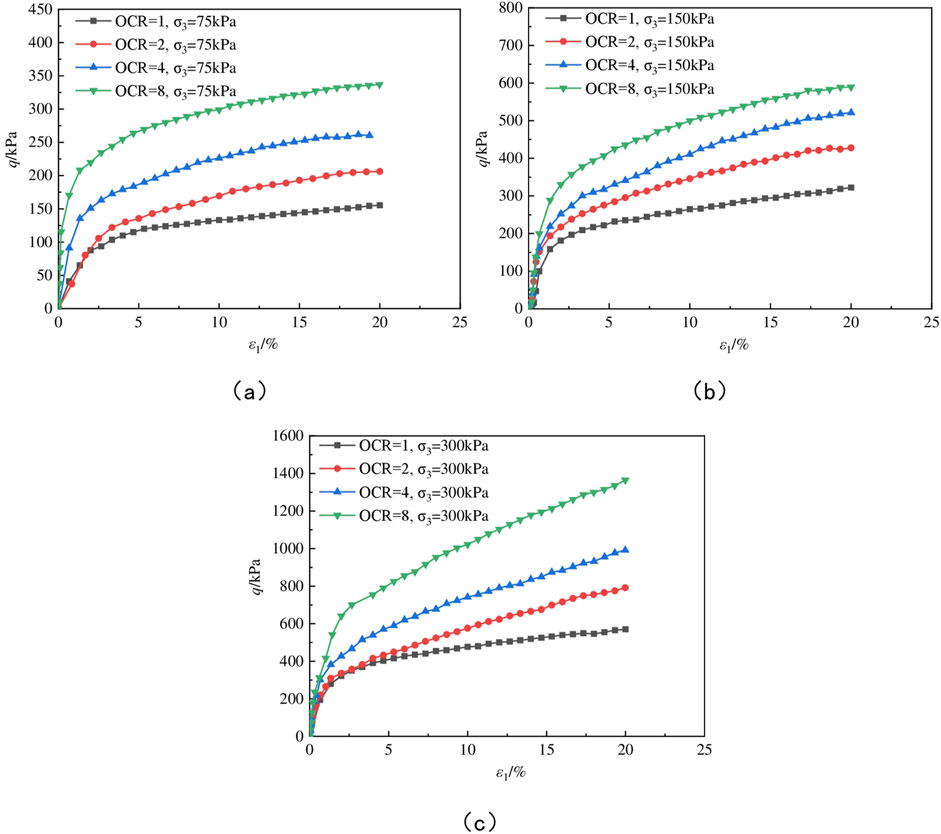
Figure 5. Stress-strain relationship under over-consolidated state: (a) σ3 = 75 kPa; (b) σ3 = 150 kPa; (c) σ3 = 300 kPa.
Under the shear confining pressure of 150 kPa, the relationship between pore pressure and axial strain under different over-consolidation ratios is shown in Figure 6. As shown in Figure 6, the excess pore pressure first increases to its peak value and then decreases for each specimen, which indicated a dilation behavior. Even normally consolidated specimens show dilation behavior and such behavior was more obvious for specimens with higher OCRs as the excess pore pressures decrease more significantly. When OCR = 1, the pore pressure shows an upward trend at the primary stage. As the shear proceeds, the pore pressure decreases after reaching the peak value. The change trend of pore pressure under OCR = 2 is generally the same as that of OCR = 1, but the peak value of pore pressure decreases. For the curve of a highly over-consolidated specimen, such as when OCR = 4 and 8, the stage of excess pore pressure building up was short and the positive peak value was small, while the final negative excess pore pressure was significant. Compared with the normal consolidation state, the pore pressure decreases rapidly after reaching the peak value under the over-consolidation state and even shows negative pore pressure.
3.5 Effective stress path
Figure 7 shows the effective stress paths of the tests under different confining pressures. It can be seen from Figure 7 that for tests under normal consolidation, the stress paths first go towards the left, which is similar to the contraction behavior of typical sands and clays. The paths then reach a phase transformation point (PTP). After that, the stress path turned right and rose along the critical state line (CSL) before reaching the critical state. It can be seen that the stress path under a normal consolidation state presents an “S” shape as a whole. The behaviors under different confining pressures for the normally consolidated specimens all showed a similar pattern of stress paths and clear PTPs. This characteristic is different from that of typical clays and sands, and this is why this kind of soil is termed transitional soil. If the three PTPs for the normally consolidated specimens are connected, the phase transformation line (PTL) is obtained as shown in Figure 7, The slope is about 1.02, slightly smaller than the slope of the CSL (M = 1.37).
The stress paths for the over-consolidated specimens are plotted in Figure 8. There is a slight deviation for the stress paths under over-consolidation with normally consolidated specimens. For the stress paths of the lightly over-consolidated specimens, there are also PTPs around the PTL, though they are less obvious compared to the normally consolidated cases. The lightly over-consolidated specimen with OCR = 2 here only showed very little tendency of contraction, which could be seen by the almost straight-up stress path during the initial loading. As the OCR increased, the specimens showed some tendency of dilation during the initial loading, such as the highly over-consolidated specimen with OCR = 4 and 8. Combined with the corresponding pore pressure curve shown in Figure 6 which shows a significant downward trend in the early stage of shearing. It shows that the dilatancy of the soil gradually increases with the increase of OCR. These observations indicate that the silt tended to be more dilative than typical silts due to its high silt (Wang et al., 2022).
3.6 Strength analysis
The test results of shear confining pressures of 75 kPa, 150 kPa, and 300 kPa were selected to draw the Mohr stress circle under different OCRs, as shown in Figure 9. Based on this, the undrained shear strength index of silt under the over-consolidation state is obtained. Figure 10 shows the variation of consolidated undrained shear strength index of saturated silt over-consolidation ratio. It can be seen from Figure 10 that the cohesion and internal friction angle increase with OCR increasing. The cohesion of soil is the result of the combined effects of physical and chemical interactions among particles, water action, mechanical interlocking and external factors. Cohesion of cohesive soil is relatively high, while that of non-cohesive soil is relatively low. Between clayey soil and sandy soil, the cohesion of silt is usually not zero. The magnitude of cohesion is influenced by various factors, such as density and water content. In this study, the void ratio of the tested soil is 0.65, which is relatively low, and the cohesion is expected to be significantly high. The undrained behavior of typical clays is significantly influenced by OCR, exhibiting pronounced dilatancy under lightly overconsolidated conditions. This manifests as initial stress path deviation towards the right with indistinct phase transformation, accompanied by substantial increases in friction angle with OCR (Ladd, 1977; Holtz et al., 2010). In contrast, typical silts or silty sands show limited OCR dependence, with stress paths initially shifting leftward, distinct phase transformation points, and minor variations in friction angle (Izadi, 2006; Wang and Luna, 2012). The tested over-consolidated silt demonstrated strong dilatancy and significant friction angle enhancement with OCR, suggesting behavior more akin to typical clays - a phenomenon likely attributable to its high fines content.
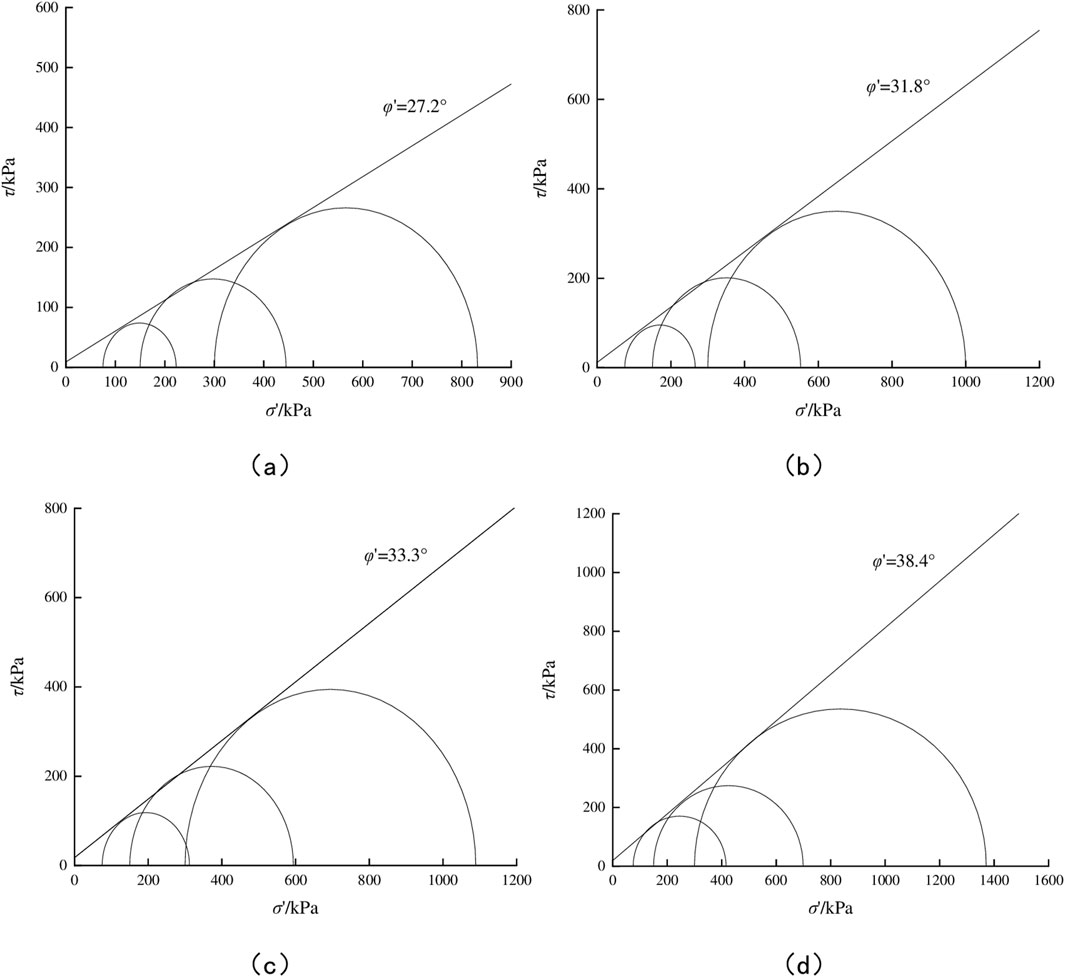
Figure 9. Mohr stress circle under different OCRs: (a) OCR = 1; (b) OCR = 2; (c) OCR = 4; (d) OCR = 8.
The stress-strain curve is normalized by effective consolidation stress, as shown in Figure 11. Figure 11 shows that the mechanical behavior of normally consolidated specimens could be normalized by the consolidation pressure with only a slight deviation. This is consistent with Ladd and Foott (1974), who found that the deviator stress of clays could be normalized by the effective vertical consolidation pressure for specimens with the same OCR. A similar conclusion has been made for the MRV silt by Wang and Luna (2012).
The undrained shear strength of fine silts can be similarly normalized with relatively small variations, which was shown by Wang and Luna (2012). In this work, the undrained shear strength of silt is also normalized by the effective consolidation pressure. The variation of normalized shear strength Su/
For the relationship between the undrained shear strength and the over-consolidation ratio of over-consolidated soil, Ladd (1991) proposed the prediction formula of over-consolidation soil by studying the normalization results of the shear strength of different soils, as shown in Equation 1:
where Su represents the shear strength,
4 SEM test
4.1 Test scheme of SEM
In order to investigate the microstructure change of soil under an over-consolidated state and its relationship with macroscopic mechanical properties, the samples of the triaxial shear test were selected for electron microscope scanning analysis. A soil strip with dimensions of 30 × 10 × 10 mm3 was cut from the triaxial specimen along the shear failure zone after unloading. The specimen was then frozen and subjected to vacuum treatment, followed by surface coating with gold to enhance its electrical conductivity. Then, Cryo-FIB (Cryo-Focused Ion Beam) was used to scan the microscopic samples and obtain SEM images. After that, the SEM images were processed by particle (pore) and crack quantitative analysis system (PCAS) to obtain a series of microstructure parameters. The mechanical properties of silt during triaxial shear tests are analyzed in combination with parameter evolution.
The test scheme is shown in Table 4. The serial X is normally consolidated with different confining pressures, which is used to explore the effect of confining pressure on the microstructure. Among them, X5 is only consolidated to examine the shear process on the variation of microstructure compared with X2. Serial Y is the sample with different OCRs. Compared to X2 under normal consolidation with the same confining pressure, the effect of OCR on the microstructure is discussed.
Electron scanning images of X2 are shown in Figure 14. Figure 14a shows the microstructure of 100 times magnification of the soil sample. It can be seen that the relative position of particles and pores within the field of vision of 100 times. However, it is not clear enough for the observation of structural types, particles, and pore morphology. To further study the soil sample, the local region in the soil sample is enlarged to 200 times to get Figure 14b. The figure shows that the micromorphology of the soil samples is relatively uniform. Enlarge the local region of Figure 14b further to 500 and 1,000 times, the micromorphology of the soil sample is shown in Figures 14c,d. Under the magnification of 500 times and 1,000 times, although the particles and pore morphology can be clearly distinguished, the number of particles is too small. The selected observation area is not representative enough, which will affect the reliability of the analysis results. Therefore, considering the observed image is clear enough and thoroughly representative of accuracy, this paper selects the electron microscope image at 200 times magnification for subsequent analysis.
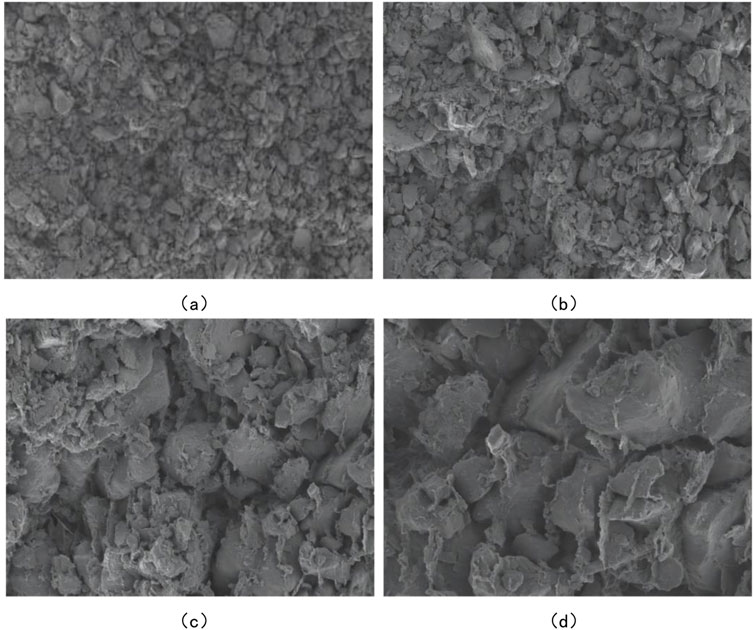
Figure 14. Different magnification of SEM images: (a) 100 times; (b) 200 times; (c) 500 times; (d) 1,000 times.
4.2 Image processing
The PCAS image processing software developed by Nanjing University is used to quantitatively analyze the SEM images. After selecting the appropriate multiple, the SEM image is processed by brightness correction and binarization to identify pores and particles. Then, the basic microscopic parameters and quantitative parameters can be obtained.
The binarization processing of SEM images with 200 times magnification under different confining pressures and OCRs is shown in Figure 15. In the figure, the black part represents particles, and the white part indicates pores. Comparing Figures 15a–d, it can be seen that the number of white areas decreases as the consolidation confining pressure increases. It indicates that the number and area of pores in the soil gradually decrease with increasing confining pressure. It can be seen from Figure 15e that the particles of the consolidated soil sample are denser before shearing compared to Figure 15b. After shearing, the position of the soil particles changes, which leads to the number of pores and pore area in the soil increasing. Comparison between Figures 15b,e–g shows that the number and area of white areas which also represent pores decrease with the increase of OCR. In addition, the distribution of the white area is also more orderly under over-consolidation, indicating the arrangement of pores is more concentrated in the direction.
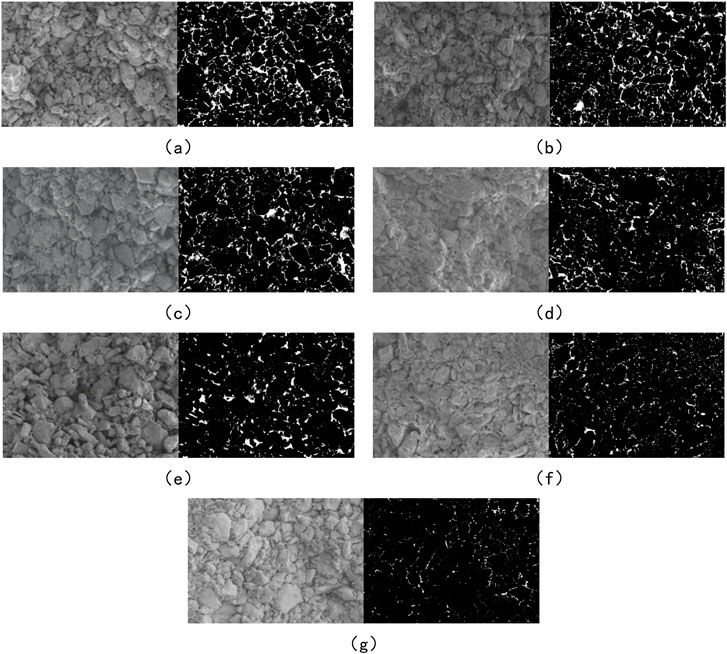
Figure 15. Binary processing of different samples: (a) X1, OCR = 1,
4.3 Quantitative analysis
To further study the influence of OCR and confining pressure on the variation of microstructure, the statistically quantitative parameters such as probability entropy, average shape coefficient, and pore fractal dimension under different confining pressures and OCRs are selected for analysis.
4.3.1 Apparent porosity
The porosity directly reflects the situation of particles and pores in the soil. Apparent porosity n is the ratio of the area of the pores to the total area of the image. Figure 16a,b show the variation of porosity with confining pressure and OCR. The soil would have a larger total pore volume and more developed pores when the porosity is larger. This indicates that the soil has a weaker ability to resist external stress and thus the deformation is higher. It can be seen from Figure 16 that the apparent porosity decreases with the increase of confining pressure and OCR. It indicates that silt is denser under higher confining pressure and OCR, which shows a stronger ability to resist deformation. This is consistent with the conclusion that the shear strength is higher under higher confining pressure and OCR.
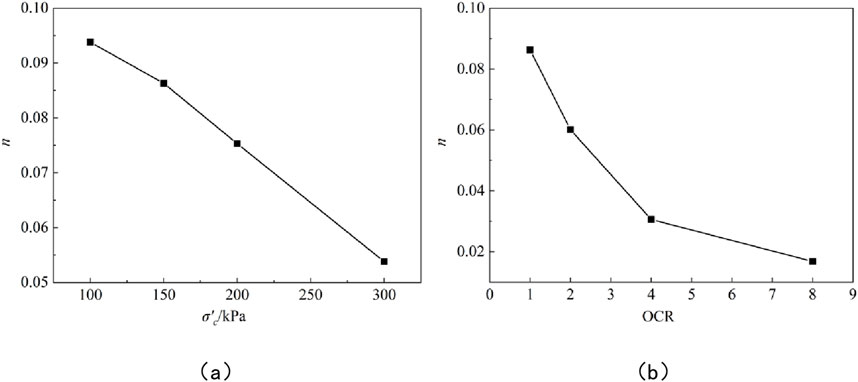
Figure 16. Apparent porosity variation with confining pressure and OCR: (a) Variation of n with confining pressure; (b) Variation of n with OCR.
4.3.2 Average shape coefficient
The average shape coefficient F can explain the shape characteristics of the particles (or pores) in the two-dimensional plane. According to Equation 2, the average shape coefficient F can be defined as:
where Fi denotes the shape coefficient and m is the total number of soil particles (or pores) in the selected SEM image. The shape factor Fi is defined by Equation 3 as:
where Cc is the circumference of an area equal to a particle or pore, and Sa denotes the actual perimeter of a particle or pore. The value of F ranges from 0 to 1. The closer the value of F is to 1, the closer the soil particles (or pores) are to the shape of a circle. On the contrary, the particle shape is sharper and longer when F is close to 0.
Figure 17 shows the variation of the average shape coefficient F with confining pressure and OCR. It can be seen from Figure 17a that the average shape coefficient F increases with the increase of confining pressure under a normal consolidation state. Under the same confining pressure, the average shape coefficient F increases obviously with the increase of OCR, as shown in Figure 17b. It can be seen that the grain shape is closer to circular with the increase of confining pressure and OCR. Combining the variation law of porosity in Figure 16, the porosity decreases with the increase of confining pressure and OCR. So the small particles may be aggregated into soil particles and thus the contact area between soil particles increases. Therefore, the shape of soil particles is close to round and the average shape coefficient F is close to 1.
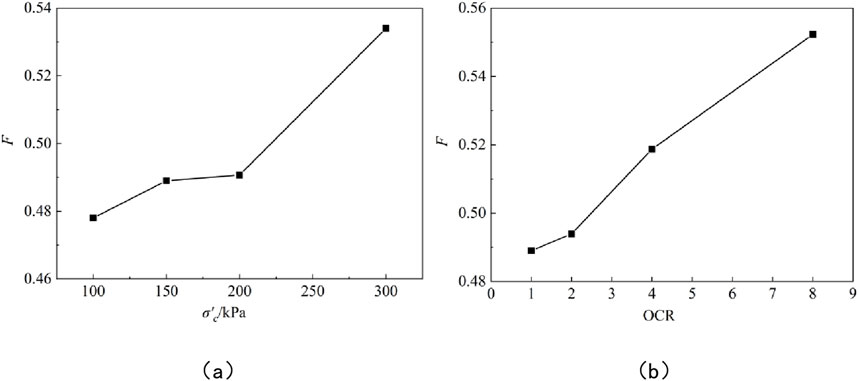
Figure 17. Average shape coefficient F variation with confining pressure and OCR: (a) Variation of F with confining pressure; (b) Variation of F with OCR.
4.3.3 Average fractal dimension
The average fractal dimension is the average fractal dimension of all pores. The average fractal dimension Dv can be defined by Equation 4 as:
where r is the length of the side to split the image, and N(r) is the total number of containing pores in the grid with side length r. The average fractal dimension of pores is the average of the fractal dimensions of all pores in the selected image. It can directly reflect the pore size of different sizes and then reflect the distribution density and complexity of soil particles. A larger fractal dimension Dv usually represents a worse uniformity degree of the pores and a larger size difference between the pores. It also indicates a more complex pore structure and a further deviation of the spatial morphology to the smooth surface.
When analyzing the fractal dimension of pores, the larger the average fractal dimension of pores, the more complex the structure of pores, and the farther the spatial morphology of pores deviates from the smooth surface. Figure 18 shows the variation of average fractal dimension Dv with confining pressure and OCR. When the confining pressure and OCR are low, the average fractal dimension Dv of the pore is high. It indicates that the size of each pore is quite different and the degree of homogenization of the pore is also poor. Under this circumstance, the pore structure is complex and the pores are relatively unsmooth in the spatial morphology characteristics. The pore complexity decreases and the shape of each pore is relatively close with the increase of confining pressure and OCR. On the other hand, the decrease rate of pore average fractal dimension Dv decreases. The reason may be that the shape of each pore becomes closer and the complexity of the pores is further reduced with the increase of confining pressure and OCR.
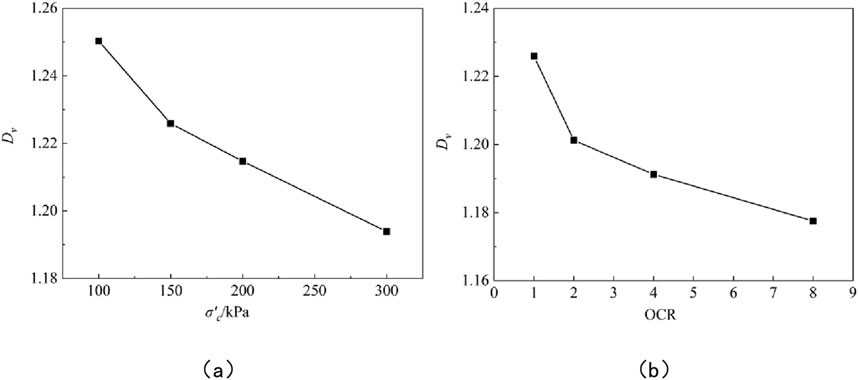
Figure 18. Average fractal dimension Dv variation with confining pressure and OCR: (a) Variation of Dv with confining pressure; (b) Variation of Dv with OCR.
4.4 Strength analysis
In order to explore the relationship between the soil microstructure and the mechanical characteristics, the variation of apparent porosity and peak strength relationship is shown in Figure 19. It can be seen from Figure 19 that the peak strength gradually decreases with the increase of the apparent porosity. The pore volume is compressed as the confining pressure and OCR increase, as shown in Figure 16. As the reduction of porosity, the internal pore volume reduces and the contact area between soil particles increases. As a result, the force transfer effect is enhanced and the sliding friction and bite friction between soil particles increases. Therefore, the soil shows a larger peak strength at the macro level and the ability to resist shear deformation is stronger. At the same time, the stress-strain curve of soil shows a more obvious hardening characteristic, which is consistent with the conclusion in Section 3.
5 Conclusion
This paper presented the triaxial undrained shear test and corresponding SEM test of the Yellow River alluvial silt under different confining pressures and OCRs. The stress-strain behavior, effective stress path, and strength during the triaxial shear test are analyzed. Meanwhile, SEM image processing and quantitative analysis are carried out. The relationship between macroscopic strength characteristics and the microscopic apparent porosity is also discussed. The main experimental observations and conclusions can be summarized as follows:
(1) The Yellow River silt, characterized by its high fines content, exhibits strain hardening behavior under normal consolidation due to particle sliding and rearrangement during shearing, leading to progressive compaction and enhanced interparticle bonding effects. The stress path initially shows contractive tendencies before transitioning to dilatant behavior, demonstrating distinct phase transformation. Under various confining pressures, the ultimate stress states converge on the critical state line with a slope of 1.37, which exceeds the phase transformation line slope of 1.02.
(2) The over-consolidation ratio exerts a substantial influence on the undrained shear behavior of Yellow River silt. With increasing OCR, the soil demonstrates not only enhanced shear strength but also more pronounced dilatant characteristics. This behavior manifests through three distinct features: immediate rightward deviation of the stress path during initial shearing phases, complete disappearance of the phase transformation state, and the development of negative excess pore water pressure commencing from the early stages of shearing.
(3) The normalized undrained shear strength of the silt increases with the rise in OCR, and its development trend aligns well with empirical formulas. As the OCR increases from 1 to 8, the particle contacts become tighter, resulting in a 1.5-fold increase in cohesion and a 50% increase in the internal friction angle.
(4) Under high confining pressure and OCR conditions, the silt exhibits a higher density, and its particle shapes become more rounded. As the OCR increases from 1 to 8, the apparent porosity n decreases by 80%, and the average shape factor F increases by 12%. The average fractal dimension Dv shows minor changes with OCR, decreasing by approximately 5%, and the rate of reduction gradually diminishes as the OCR increases.
(5) The macroscopic peak strength gradually decreases with the increase of the microscopic apparent porosity. This might be the internal pore volume reduced and the contact area between soil particles increases as the reduction of porosity. Then the force transfer effect is enhanced and the sliding friction and bite friction between soil particles increase. This demonstrates a significant correlation between the microscopic and macroscopic experimental results.
Data availability statement
The original contributions presented in the study are included in the article/supplementary material, further inquiries can be directed to the corresponding author.
Author contributions
YW: Conceptualization, Resources, Writing - review and editing. WW: Supervision, Validation, Writing - original draft. YC: Data curation, Software, Visualization, Writing - review and editing. TW: Validation, Visualization, Writing - original draft. SC: Software, Validation, Writing - review and editing. MD: Investigation, Methodology, Writing - original draft. ZD: Conceptualization, Formal Analysis, Funding acquisition, Project administration, Writing - review and editing.
Funding
The author(s) declare that financial support was received for the research and/or publication of this article. The study is financially supported by the National Natural Science Foundation of China (Grant Nos. U22A20598 and 51908513), Key Research & Development and Promotion Project of Henan Province (Grant No. 242102321025 and 241111322500).
Conflict of interest
Authors YW, WW, YC, TW, and SC were employed by The Seventh Engineering Co., Ltd. of CCCC First Highway Engineering Co., Ltd.
The remaining authors declare that the research was conducted in the absence of any commercial or financial relationships that could be construed as a potential conflict of interest.
Generative AI statement
The authors declare that no Generative AI was used in the creation of this manuscript.
Publisher’s note
All claims expressed in this article are solely those of the authors and do not necessarily represent those of their affiliated organizations, or those of the publisher, the editors and the reviewers. Any product that may be evaluated in this article, or claim that may be made by its manufacturer, is not guaranteed or endorsed by the publisher.
References
Cheng, Y. Y., Gao, X. G., Liu, T. H., Li, L., Du, W., Hamad, A., et al. (2022). Effect of water content on strength of alluvial silt in the Lower Yellow River. Water 14 (20), 3231. doi:10.3390/w14203231
Du, Z. B., Zhang, Z., Wang, L., Zhang, J. W., and Li, Y. H. (2023). Effect of moisture content on the permanent strain of Yellow River alluvial silt under long-term cyclic loading. Sustainability 15 (17), 13155. doi:10.3390/su151713155
Fakharian, K., Shafiei, M., and Hafezan, S. (2022). Investigation of soil setup effects on pile response in clay considering over-consolidation ratio and installation method through physical modeling. Can. Geotech. J. 60, 488–503. doi:10.1139/cgj-2021-0686
Fletcher, L., Hungr, O., and Evans, S. G. (2002). Contrasting failure behaviour of two large landslides in clay and silt. Can. Geotech. J. 39 (1), 46–62. doi:10.1139/t01-079
Gao, Q., Ge, J., Zhang, J., Ren, Z., Wu, D., Cheng, G., et al. (2023). Experimental study on the engineering characteristics of modified silt in the Yellow River alluvial plain. Constr. Build. Mater. 398, 132491. doi:10.1016/j.conbuildmat.2023.132491
Gens, A., and Alonso, E. E. (1992). A framework for the behaviour of unsaturated expansive clays. Can. Geotech. J. 29 (6), 1013–1032. doi:10.1139/t92-120
Holtz, R. D., Kovacs, W. D., and Sheahan, T. C. (2010). An introduction to geotechnical engineering. 2nd ed. Upper Saddle River, NJ, United States: Pearson Prentice-Hall.
Hu, X. R., Dong, X. L., Chen, X. Y., and Hu, B. Y. (2018). The elasto-plastic constitutive model and tri-axial numerical simulation for saturated over-consolidated clay. Chin. J. Appl. Mech. 35 (01), 28–35 in Chinese.
Iravani, S. (1999). Geotechnical characteristics of penticton silt. Edmonton: University of Alberta.
Kulhawy, F. H., and Mayne, P. W. (1990). “Manual on estimating soil properties for foundation design,” No. EPRI-EL-6800. Palo Alto, CA, Ithaca, NY (USA): Electric Power Research Inst, Cornell Univ., Geotechnical Engineering Group.
Ladd, C. C. (1977). “Stress-deformation and strength characteristics, state of the art report.”in Proc. of 9th ISFMFE, Tokyo, Japan, July 10–15, 1977
Ladd, C. C. (1991). Stability evaluation during staged construction. J. Geotech. Eng. 117 (4), 540–615. doi:10.1061/(asce)0733-9410(1991)117:4(540)
Ladd, C. C., and Foott, R. (1974). New design procedure for stability of soft clays. J. Geotech. Eng. 100 (7), 763–786. doi:10.1061/ajgeb6.0000066
Lashkari, A., Shourijeh, P. T., Khorasani, S. S., Irani, N., and Rahman, M. M. (2022). Effects of over-consolidation history on flow instability of clean and silty sands. Acta Geotech. 17 (11), 4989–5007. doi:10.1007/s11440-022-01502-y
Li, D., Yin, K., Glade, T., and Leo, C. (2017). Effect of over-consolidation and shear rate on the residual strength of soils of silty sand in the Three Gorges Reservoir. Sci. Rep. 7 (1), 5503. doi:10.1038/s41598-017-05749-4
Liu, Z., Liu, F. Y., Ma, F. L., Wang, M., Bai, X. H., Zheng, Y. L., et al. (2016). Collapsibility, composition, and microstructure of loess in China. Can. Geotech. J. 53 (4), 673–686. doi:10.1139/cgj-2015-0285
Monkul, M. M., Etminan, E., and Senol, A. (2017). Coupled influence of content, gradation and shape characteristics of silts on static liquefaction of loose silty sands. Soil Dyn. Earthq. Eng. 101, 12–26. doi:10.1016/j.soildyn.2017.06.023
Nagase, H., Shimizu, K., Hiro-Oka, A., Mochinaga, S., and Ohta, M. (2000). “Effects of over-consolidation on liquefaction strength of sandy soil samples,” in The proceedings of the 12th world conference on earthquake engineering, Auckland, New Zealand.
Nazir, A. K. (2011). Effect of motor oil contamination on geotechnical properties of over consolidated clay. Alexandria Eng. J. 50 (4), 331–335. doi:10.1016/j.aej.2011.05.002
Romero, E., and Simms, P. H. (2008). Microstructure investigation in unsaturated soils: a review with special attention to contribution of mercury intrusion porosimetry and environmental scanning electron microscopy. Geotech. Geol. Eng. 26 (6), 705–727. doi:10.1007/s10706-008-9204-5
Song, X. G., Zhang, H. B., Wang, S. G., Jia, Z. X., and Guan, Y. H. (2010). Hydrophilic characteristics and strength decay of silt roadbed in Yellow River alluvial plain. Chin. J. Geotech. Eng. 32 (10), 1594–1602 in Chinese.
Vithana, S. B., Nakamura, S., Kimura, S., and Gibo, S. (2012). Effects of overconsolidation ratios on the shear strength of remoulded slip surface soils in ring shear. Eng. Geol. 131, 29–36. doi:10.1016/j.enggeo.2012.01.015
Wang, S., and Luna, R. (2012). Monotonic behavior of Mississippi River Valley silt in triaxial compression. J. Geotech. Geoenviron. Eng. 138 (4), 516–525. doi:10.1061/(asce)gt.1943-5606.0000603
Wang, X., Yuan, R., and Cui, K. (2023). Modified unified critical state model for soils considering over-consolidation and cyclic loading behaviours. Sci. Rep. 13 (1), 3024. doi:10.1038/s41598-022-26624-x
Wang, Y., Cao, T., Gao, Y., and Shao, J. (2022). Experimental study on liquefaction characteristics of saturated Yellow River silt under cycles loading. Soil Dyn. Earthq. Eng. 163, 107457. doi:10.1016/j.soildyn.2022.107457
Wang, Z. C., Jin, G., Deng, X. H., and Dong, H. (2016). Experimental study on the over-consolidation stress history of subgrade compacted clay. J. Highw. Transp. Res. Dev. Engl. Ed. 10 (1), 26–32. doi:10.1061/jhtrcq.0000482
Xiao, J. H., Juang, C. H., Xu, C., Li, X. W., and Wang, L. (2014). Strength and deformation characteristics of compacted silt from the lower reaches of the Yellow River of China under monotonic and repeated loading. Eng. Geol. 178, 49–57. doi:10.1016/j.enggeo.2014.06.008
Xiao, J. H., Liu, J. K., Peng, L. Y., and Chen, L. H. (2008). Effects of compactness and water Yellow-River alluvial silt content on its mechanical behaviors. Rock Soil Mech. 29 (2), 409–414 in Chinese. doi:10.16285/j.rsm.2008.02.043
Yang, S. S., Wang, M., Lian, X. G., and Zhao, W. J. (2019). Properties study on over-consolidated loess and normally consolidated loess. Min. Res. Dev. 39 (05), 122–125 in Chinese. doi:10.13827/j.cnki.kyyk.2019.05.025
Yi, X. M., Wang, S. G., Liu, Z. Q., and Xu, G. (2013). Influence of water content on the strength of silt soil in yellow river alluvial plain. Appl. Mech. Mater. 256, 481–487. doi:10.4028/www.scientific.net/amm.256-259.481
Zhang, J., Li, G., Ding, S., Tian, H., Ren, X., Liu, M., et al. (2022). Distribution characteristics of soil particles and their relationships with soil organic carbon components in the alluvial/sedimentary zone in the lower reaches of the yellow river. Front. Environ. Sci. 10, 849565. doi:10.3389/fenvs.2022.849565
Zhang, J. R., Song, C. Y., Jiang, T., Wang, L. J., Zhao, J. Z., and Xiong, T. Q. (2023). Hydromechanical characteristics and microstructure of unsaturated loess under high suction. Rock Soil Mech. 44 (08), 2229–2237 in Chinese. doi:10.16285/j.rsm.2022.1298
Keywords: silt, over-consolidation ratio, undrained shear strength, friction angle, microstructure
Citation: Wu Y, Wang W, Chen Y, Wang T, Chai S, Ding M and Du Z (2025) Effects of OCR on the static characteristics and microstructure of Yellow River silt. Front. Earth Sci. 13:1547297. doi: 10.3389/feart.2025.1547297
Received: 18 December 2024; Accepted: 22 April 2025;
Published: 09 May 2025.
Edited by:
Jair de Jesús Arrieta Baldovino, University of Cartagena, ColombiaReviewed by:
Changshuo Wang, Ningbo University, ChinaElfa Ali Idrus, Padjadjaran University, Indonesia
Copyright © 2025 Wu, Wang, Chen, Wang, Chai, Ding and Du. This is an open-access article distributed under the terms of the Creative Commons Attribution License (CC BY). The use, distribution or reproduction in other forums is permitted, provided the original author(s) and the copyright owner(s) are credited and that the original publication in this journal is cited, in accordance with accepted academic practice. No use, distribution or reproduction is permitted which does not comply with these terms.
*Correspondence: Zibo Du, ZHV6aWJvQHp6dS5lZHUuY24=
 Yongmei Wu1,2
Yongmei Wu1,2 Mengxiang Ding
Mengxiang Ding Zibo Du
Zibo Du



